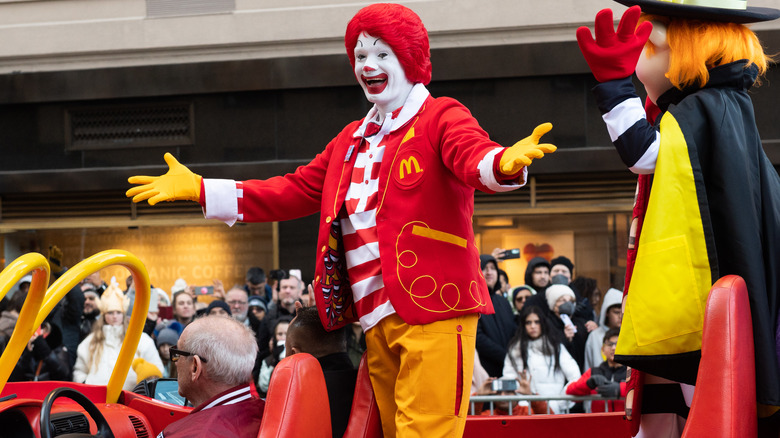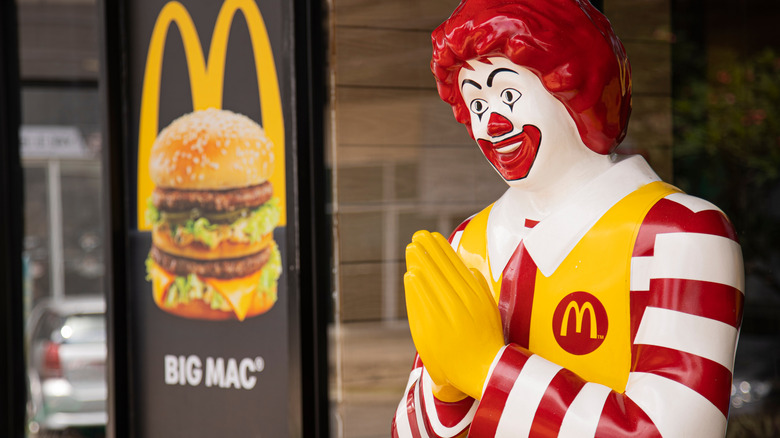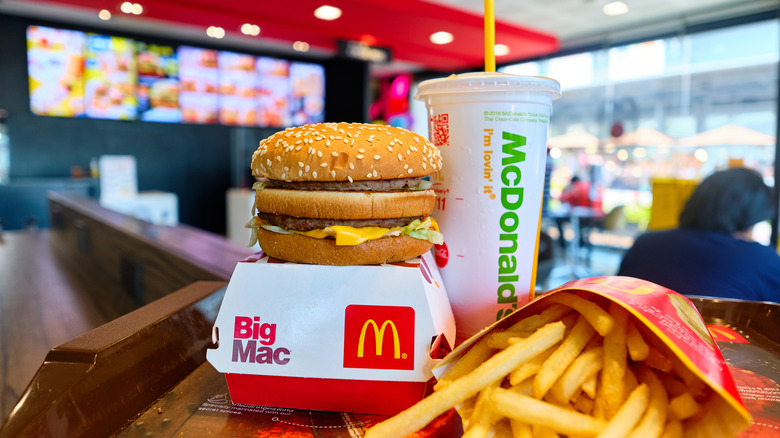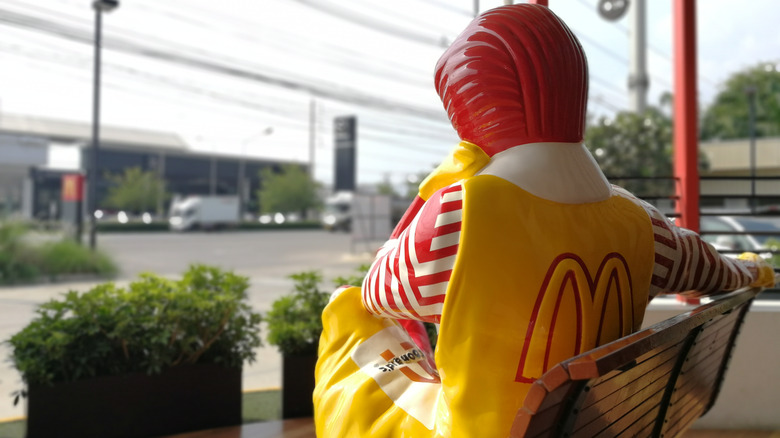Whatever Happened To Ronald McDonald?
You'd think the appeal of juicy burgers and crispy fries would be enough to entice diners to sample some delectable fast food. However, many establishments have used mascots to raise the profiles of their restaurants over the years. You have Chuck E. Cheese, an affable mouse-like creature and pizza purveyor who introduces the joys of gambling to children. Then there's Grimace, McDonald's bizarre purple mound that supposedly represents a taste bud, at least, according to Insider. Of course, Grimace is just one in a pantheon of McDonald's mascots, and it's safe to say that Ronald McDonald is their fearless leader.
Well, he used to be. The so-called "Chief Happiness Officer" has been lying low as of late, and speculation is rampant regarding exactly what happened to this jolly fellow. The once ubiquitous fixture in commercials and public appearances has much less of a presence these days, and the reasons are as complex as the necromancy needed to bring McDonald's ice cream machine back to life. But to truly understand the clown prince of fries, one must first delve into his history.
The slightly unsettling history of a clown named Ronald
Surprisingly, there was a time when clowns inspired laughter and joy as opposed to abject fear. Reader's Digest describes the influence iconic clown Bozo had on the creation of Ronald McDonald thanks to the enterprising ad executive Barry Klein. In the 1960s, Klein recognized that McDonald's could ride Bozo's jaunty coattails by developing a fun-loving character of their own to be used in advertising. Thus, the first iteration of Ronald McDonald was born, as portrayed by famed weather forecaster Willard Scott (per PBS).
Ronald's first look was a bit rough, to put it lightly. The bulbous red nose commonly associated with clowning was replaced by a paper cup bearing the McDonald's logo. On top of his head was a fast-food tray featuring replicas of milkshakes, fries, and a burger. Most egregious was Ronald's belt, which was a mysterious accessory that contained a seemingly endless supply of hamburgers. Once the advertising campaign went national, Ronald's look was updated to present a more sophisticated figure of buffoonery. However, the world of clowning would eventually take a dark turn that tarnished Ronald's reputation for good.
Creepy clowns and childhood obesity spell an end to an era
Let's travel back to the recent past of 2016 and its odd obsession with creepy clowns. According to People, spates of "clown sightings" occurred all over the U.S. and elsewhere in the world. These sightings mostly involved harmless pranks, but there were occasional reports of legitimate criminal wrongdoing. The craze led McDonald's to make some tough decisions regarding its mascot, per NBC News. In a statement released to the press, a spokeswoman for McDonald's highlighted "the current climate around clown sightings in communities," and thought it best for Ronald to take a backseat.
Creepy clown crazes notwithstanding, Mcdonald's was already facing some backlash against its formerly beloved mascot. The 2004 documentary "Super Size Me" called attention to the nutritional deficits of an all-McDonald's diet. Just a few years later in 2011, concerns were raised regarding Ronald's effect on children's eating habits, as explained by CNBC. Citing fears about the health impact of childhood obesity, Corporate Accountability International launched a campaign against the mascot and requested that McDonald's cease using him for marketing purposes. While McDonald's downplayed these concerns and claimed they had no intention of retiring Ronald, it seems that creepy clown scares accomplished what advocacy groups could not.
A petition to bring back McDonaldland characters of yore
Despite society's collective distaste for clowns or concerns that Ronald McDonald is helping fuel a public health crisis, people just can't let go of this iconic fast food mascot. A recent Change.org petition passionately calls for the return of Ronald and the other McDonaldland characters like Grimace and the Hamburglar. The petition, which now has 216 signatures, highlights the many fond childhood memories established by these brightly colored mascots and requests that they are included in future advertising campaigns. Signers of the petition are just as passionate about the cause as the creator, based on their comments. One proclaims, "These characters were my childhood," while another simply states, "I miss 'em."
Although the dominance of McDonaldland may be in the rear view of popular culture, one can't deny the hold it had on children of a specific era. A YouTube video shared by Rad Retro showcases the majesty of McDonald's PlayPlace in the 70s and 80s. Additionally, the fervor extended well into the late 90s, which saw the release of videos like "The Wacky Adventures of Ronald McDonald: Scared Silly," (per IMDb).
While there's no telling what the future holds for Ronald and the crew, we do see them pop up from time to time. One photo on the McDonald's Instagram account displays the whole gang with the caption "if u need me i'll be in the comment section." Ronald may be gone (for now), but he is not forgotten.



